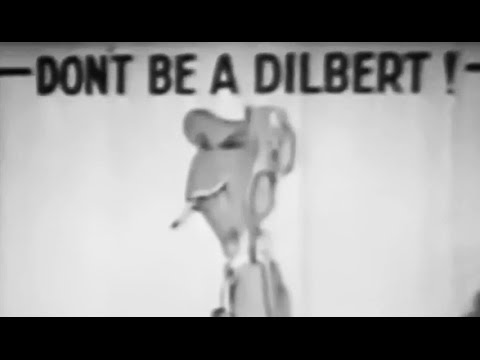US Navy Training Film playlist:
Pilot Training Film playlist:
more at
“Dilbert fearlessly provides a string of negative examples of what not to do during aerial gunnery practice.” Starring Huntz Hall (“Sach” of the Bowery Boys and Dead End Kids) as Dilbert, a character created by Robert C. Osborn.
US Navy training film MN-84d
Reupload of a previously uploaded film with improved video & sound.
Public domain film from the US Navy, slightly cropped to remove uneven edges, with the aspect ratio corrected, and one-pass brightness-contrast-color correction & mild video noise reduction applied.
The soundtrack was also processed with volume normalization, noise reduction, clipping reduction, and/or equalization (the resulting sound, though not perfect, is far less noisy than the original).
…World War II: the Dilbert Years
Osborn enlisted when World War II began, hoping to become a U.S. Navy pilot. However, the Navy apparently decided that he would be better employed with his hand wrapped around a pen rather than around a joystick: he was soon learning, then applying the art of “speed drawing”, under the command of the photographer Edward Steichen in a special information unit in which pilot training manuals were produced. Osborn began drawing cartoons of a pilot who was hapless, arrogant, ignorant and perpetually blundering in ways that put himself and his crew at unnecessary risk. The name of this character was “Dilbert the Pilot”, and “Dilbert” was soon to become a slang term used to refer to “sailor who is a foul-up or a screwball.” Scott Adams credits Osborn as an indirect source of inspiration for the main character in his own Dilbert cartoons. It is not certain how many drawings Osborn produced for Navy manuals; estimates range from 2,000 to 40,000. His Dilbert was used in numerous educational posters for Navy pilots, appeared in the New York Times and Life magazine; for a while, “dilbert” became a synonym for “blunder” for Navy pilots…
Henry Richard “Huntz” Hall (August 15, 1920–January 30, 1999) was an American radio, theatrical, and motion picture performer noted primarily for his roles in the “Dead End Kids” movies, such as Angels with Dirty Faces (1938), which gave way to the “The Bowery Boys” movie franchise, a prolific and highly successful series of comedies in the 1940s and 1950s.
Henry Richard Hall was born in 1920 in New York City to Joseph Patrick Hall, an Irish immigrant air-conditioner repairman, and his wife Mary Ellen Mullen. The 14th of 16 children, he was nicknamed “Huntz” because of his Teutonic-looking nose.
Hall attended Catholic schools and started performing on radio at age 5.
He appeared on Broadway in the 1935 production of Dead End, a play written and directed by Sidney Kingsley. Hall was then cast along with the other Dead End Kids in the 1937 film Dead End, directed by William Wyler and starring Humphrey Bogart.
Hall later played the increasingly buffoonish Horace DeBussy “Sach” Jones in 48 “Bowery Boys” films, gaining top billing when his longtime partner, Leo Gorcey, left the series in 1956.
He also appeared in other films, including his portrayal of Private Carraway in the war film, A Walk in the Sun, in 1945.
By 1976, Hall drove a brand-new Rolls-Royce, thanks to his offshore oil well investments…
Death
Hall died from congestive heart failure on January 30, 1999 at the age of 79 in North Hollywood, California. He was interred in a niche at All Saints Episcopal Church in Pasadena, California…
Friendly fire is inadvertent firing towards one’s own or otherwise friendly forces while attempting to engage enemy forces, particularly where this results in injury or death. A death resulting from a negligent discharge is not considered friendly fire. Neither is murder, whether premeditated or in the heat of the moment, nor is deliberate firing on one’s own troops for disciplinary reasons, as in these cases there is no intent to harm the enemy. Similarly, inadvertent harm to non-combatants or structures, usually referred to as collateral damage, is also not considered to be friendly fire.
The term friendly fire was originally adopted by the United States military. Many North Atlantic Treaty Organization (NATO) military refer to these incidents as blue on blue, which derives from military exercises where NATO forces were identified by blue pennants, hence “blue”, and units representing Warsaw Pact forces were identified by orange pennants. Another term for such incidents is fratricide, a word that originally refers to the act of a person killing their brother…

